| For about two decades now, the Remington 700P has been the most popular law enforcement sniping rifle, and one could probably even claim it to be the LE "standard". They are fairly affordable and have had a long track record of being accurate and easy to tune for even better performance. The 700P has gone through several development changes over the years, going from the custom shop to mass produced, to lengthening the barrel by 2" to introducing the LTR, to introducing new calibers. And the 700P is still the number one used rifle in LE sniping. It is also known that the 700P shares the same barreled actions as the varmint lineup, the same actions, same barrels, etc. (Except the .223 rifles which have a different rate of twist). So, when Remington announced an affordable varmint rifle for 2007, the SPS Varmint (SPS-V), and a SPS tactical rifle, many people were smiling. If the barreled action was the same as the P's and other Varmint rifles, then performance should be quite well. If the core is good, than it would be a great rifle to start building on. Well, of course, we need to do our part to examine the possibilities, so we ordered up a Remington 700 SPS Varmint rifle in .308 to see what we could find out about these rifles. | |
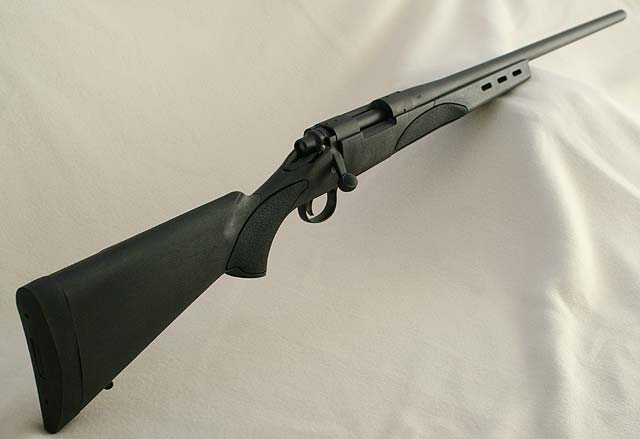 |
| The standard Remington 700 SPS rifle was designed and introduced as the 700 ADL replacement a few years ago. The ADL was the low end of the 700 lineup and the SPS now fills that role. The one very nice advantage that the SPS has over the ADL is the same hinged floorplate that is found on the BDL line of rifles. Beyond a new stock, the rest of the SPS is very ADL like. The SPS Varmint was introduced to fill that same low end niche, but for a varmint rifle, or even a tactical rifle as we are using it here. Obviously, this rifle is standard Remington 700 in terms of operation. The action is smooth and operation is simple, with the same two position safety found on the right of the rear tang. The bolt release is forward of the trigger, inside the trigger guard and the rest of the rifle is pretty much standard Remington faire. The entire metal finish on the rifle is the same fairly rough matte blue finish that is found on the other 700 SPS rifles. It certainly reduces any glare and serves a good tactical purpose. |
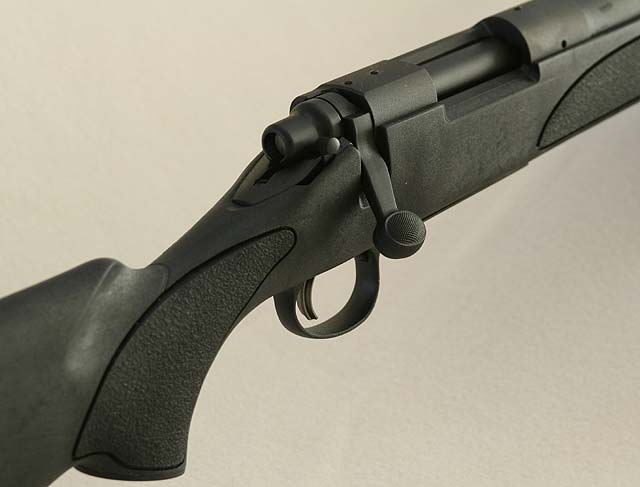 |
| The obvious place that Remington saved money was in the stock. It is an injection molded plastic stock like you would find on a low end Savage rifle. It is fairly flimsy and the fit and finish on it is pretty poor, especially where the recoil pad mates to the stock, as you can see in some of the pictures below. In all honesty though, the shape isn't too bad. The wide forend works well on sandbags. The pistol grip area is pretty thin and not nearly as comfortable as other tactical or varmint stocks, and the cheek piece area is thin also, but the semi Monte Carlo cheek piece does help support your cheek fairly well. The tactile feel has been aided in the gripping areas of the stock with some roughed up surface, and it does help. The stock does have two sling swivel studs on the forend which is a very common tactical setup, though I suspect it would be useful for varmint hunting as well. There are no pillars or bedding block of any sort, though one would not expect one on this stock or rifle with its price point. The single biggest problem with the stock, at least in my eyes, is that the barrel is not free floating. In reality, the injection molded stocks, even with the strengthening ribs inside, are just not strong enough to effectively free float a barrel (yes, I know Savage does it). The manufacturing tolerances and warping of the plastic are also additional problems when trying to free float the barrel. While these may be good reasons why the barrel on this rifle is not free floated, it does not mean that it is a good thing. I expect (and I tested it to find out for sure) that some additional accuracy could be achieved with a stock that had some good bedding, aluminum or glass, and a free floated barrel. More will be discussed about that later. |
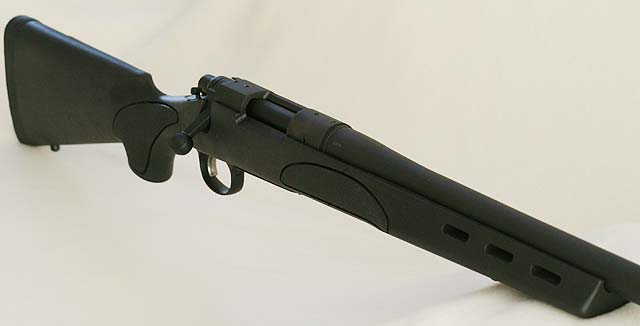 |
| The other major change in this SPS-V is the introduction and the use of the new Remington X-Mark Pro™ trigger. Now, I will be honest, I do not know if this is the future of all Remington rifles & triggers, if it is the low end rifle trigger to save money, or if this is a special trigger used on accuracy rifles. It does not appear that all Remington rifles have the new trigger, though it does seem to be more prevalent in the lower end rifles. The trigger appears to be all new and doesn't share much with the old triggers beyond the safety and bolt release mechanism. These triggers only have a single screw that adjusts the weight, instead of the three adjustment screws on the old Remington triggers. I suspect this is a good idea for the average shooter. Our rifle came from the factory set at 4.5 lbs according to our trigger scale, and there was a tiny bit of take up. That is actually not too bad for a factory trigger, and all accuracy tests were done at the factory trigger setting. To me, the biggest controversy of the trigger is the physical shape and feel of the actual trigger. Personally, I have always been very fond of the wide, ribbed, and black trigger on the Remington 700 rifles. These new X-Mark Pro triggers are thinner, smooth, and silver. The wide ribbed triggers give a very good trigger feel and is a great design. The new one is a bit more slippery, and has a rounded front which doesn't help. Of course, all that being said, I ran into no problems with the trigger and really didn't notice much of difference while in use... but still, they could have replaced the internals if they really wanted, but still left the same great trigger shape. It should also be mentioned that nothing has changed on the action or mounting of the trigger, so all of the typical after market triggers can still easily replace the X-Mark Pro trigger if you really do not like it. |
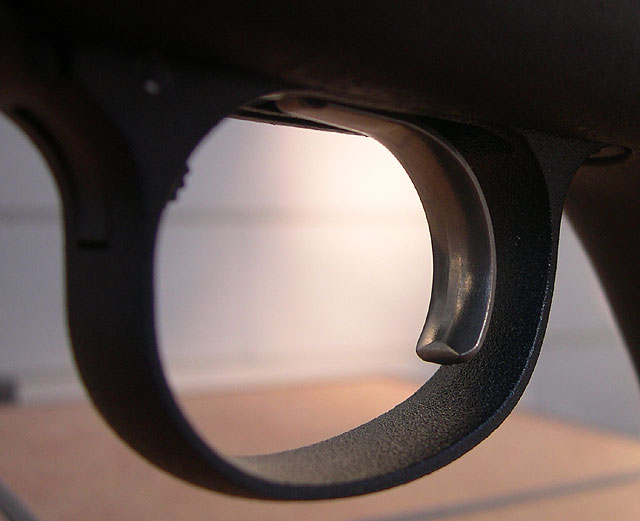 |
| Beyond that, the SPS-V is a fairly typical Remington varmint rifle that could be used for tactical work. It has the standard Remington varmint contour barrel that is also used on the 700P tactical rifles. The crown has an 11 degree target crown, not a recessed step that is more common. It is a 1:12" twist barrel which tends to favor the 168gr bullets, which is what we were going to be shooting anyway. We will eventually test the heavier 175gr bullets to see if they stabilize okay, but for this test we did not go over the 168gr bullets. We had no problems mounting a Warne rail on the rifle or the scope as we prepared for the evaluation. Yep, it is a Remington rifle, no new stories here. |
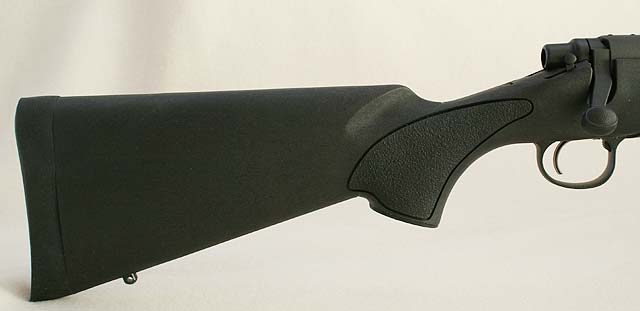 |
The range day was sunny, though it was February in Montana, so it was chilly at around 30 degrees F. Winds were calm and it was a good day for shooting. We did a brief barrel break-in while we got the scope zeroed in using some HSM 150gr range ammo. The trigger was kept at the factory setting of 4.5 lbs and then we settled in for some performance tests using primarily Federal Gold Medal Match 168gr ammunition.
The Rifle was very consistent throughout the shooting session and in reality the rifle shot quite well, especially for the price of the rifle. The trigger was fine and I quickly adapted to it and the rifle functioned flawlessly, as a Remington 700 should. The average group size for the recorded GMM groups was .725", with a best group of .660" center to center. All groups were three round groups fired from a bench and using a sand bag on the front and a sand sock at the rear. Out of the box, this Remington is a sub .75 MOA rifle, and if you remove shooter error, I'm sure the rifle is probably a bit better than that. |
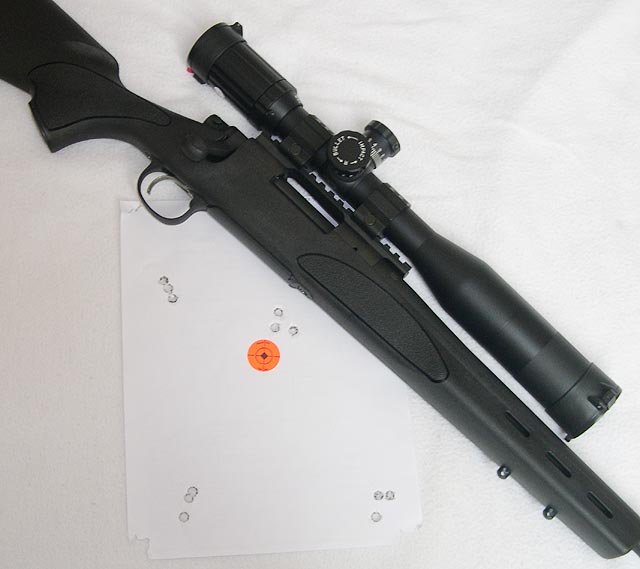 |
Now, as I mentioned before, I thought that some more accuracy may be achieved if we were to try a better stock with a free floating barrel and some sort of bedding, either an aluminum block or glass. Well, lest my readers think I was not willing to do all that I could to provide good information, I decided to do a test. So, I decided to do a direct accuracy comparison in the same conditions (as much as I was able to) using a HS Precision stock, in fact, a takeoff stock from a 700P that I happened to have on hand. In order to make the test as fair as possible I decided I would take the new stock with us to the range and immediately following the accuracy test with the factory stock I would swap over to the HS stock and fire some groups for accuracy. I would not remove the scope or mounts, and I would not clean the barrel. I wanted everything to be as equal as possible, so I even used the same T-Handle torque wrench to tighten BOTH stocks before firing. I felt it was a pretty good comparison and should show some interesting results.
Immediately after firing the factory stock groups I pulled the stock off, put the barreled action in the HS stock, and even using the same lot of federal GMM ammo, I fired some groups. Was there a change? Why yes there was, and by golly, it was an improvement. The average group size shrunk to .554" with a best group of .414" and the worst group was only .632". That is actually a fairly impressive gain for just swapping out the stock and nothing else. If my math is correct, that is about a 30% improvement. Not bad at all. With that consistent accuracy, the rifle is close to a .5 MOA rifle. Of course, when you add in the HS Precision stock along with the price of the rifle, it rings up to just about exactly what a 700P will cost you new, but, it would give you the option of using different stocks, or getting different colors or options with the HS, or a thumbhole HS, etc. As you can see in the picture below, the groups tightened up nicely with the HS stock. As a note, the bottom left group is a 4 round group, I had one bullet left in the box and figured I'd just put it in the same group. |
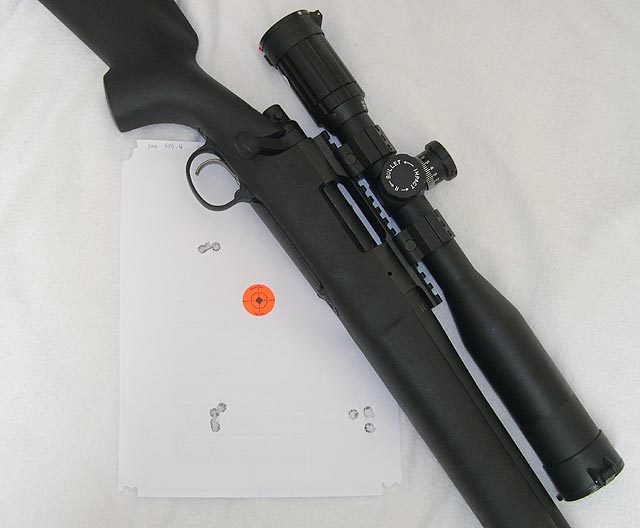 |
I suppose the review was not really about the performance or operation of the rifle as we knew what to expect there, but the review was probably more about the SPS-V stock. Could it be used as an entry level, affordable tactical rifle to compete with the Savage 10FP? Yes, it could be. The 10FP's tend to be a tad bit more accurate out of the box, but the shape of the SPS-V injection molded stock is better than the 10FP injection molded stock. They both have good after market support, but the Remington has a marked advantage there. The savage rifles are easier to work on and do changes yourself, even including changing a barrel & caliber. It would be a hard decision, and both rifles are very good for the money.
On a whole, the rifle isn't bad at all, though I would consider the stock a temporary one while you save for exactly what you or the department wants. A .75 MOA rifle out of the box certainly can serve you well and it would get the job done, and perhaps as the budget builds back up over some years, upgrades can happen, that is the beauty of the Remington 700, just keep making it better as the funds allow. The 700 SPS-V is an excellent foundation to start with. |
|








Do you have any suggestions on how to get listed in Yahoo News? I’ve been trying for a while but I never seem to get there! Appreciate it.
BalasHapusGeorge Ashley
I would really recommend Magpul Remington 700 Hunter Stock for your rifle. Awesome upgrade.
BalasHapus